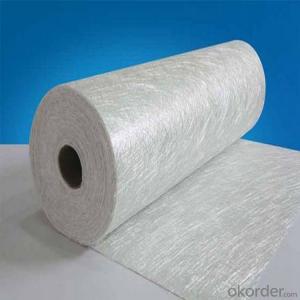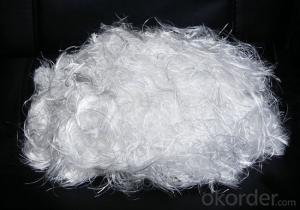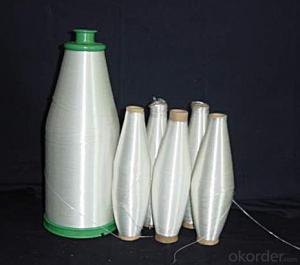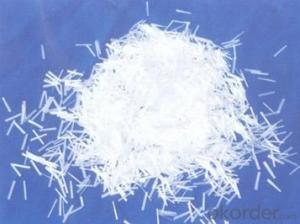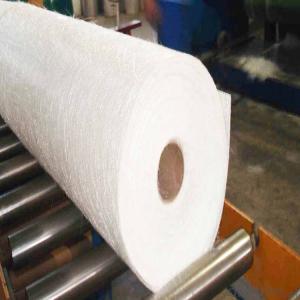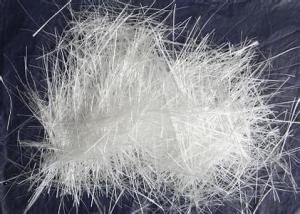E-Glass Fiber Glass Chopped Strands For BMC
- Loading Port:
- Shanghai
- Payment Terms:
- TT OR LC
- Min Order Qty:
- 20000 kg
- Supply Capability:
- 200000 kg/month
OKorder Service Pledge
OKorder Financial Service
You Might Also Like
1.Brief Introductions
E-Glass Fiber Glass Chopped Strands For BMC are compatible with unsaturated polyester, epoxy resin and phenolic resins.
The end-use applications include transportation, building & construction, electronic & electrical, mechanical, and light industry.
2.Product Features
Extremely low resin demand, delivering low viscosity to BMC paste
High impact strength; High LOI rate
High strand stiffness; Compatible with rubber
3.Product Specifications
Property | Fibre diameter | Moisture Content | Size Content | Chop |
(%) | (%) | (%) | (%) | |
Mathods | IS01888 | ISO3344 | ISO1887 | |
3mm | ±10 | ≤3.0 | 0.1±0.05 | 98 |
6mm | ||||
9mm | ||||
12mm |
Special specification can be produce according to customer requirements.
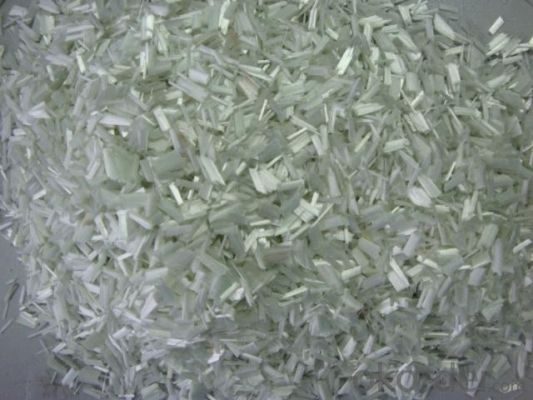
4.FAQ
Packaging:
Each bag can be taken (15-25kgs)。 Could also take a big container bag.
Storage:
Unless otherwise specified, It should be stored in a dry, cool and rain-proof area. It is recommended that the room temperature and humidity should be always maintained at 15℃~35℃ and 35%~65% respectively.
- Q:Can fiberglass chopped strand be used in the production of aerospace structures?
- Aerospace structures can benefit from the utilization of fiberglass chopped strand. This versatile material possesses numerous advantages for aerospace applications, including a high strength-to-weight ratio, excellent thermal and electrical insulation properties, and resistance to corrosion and chemicals. When it comes to manufacturing composite materials for aerospace, fiberglass chopped strand can be employed. These composites, such as fiberglass-reinforced polymers (FRPs) or fiber-reinforced composites, offer enhanced strength and durability while remaining lightweight. This characteristic is particularly crucial in aerospace applications where reducing weight is essential. Fiberglass chopped strand finds utility in reinforcing various components within aerospace structures. These components include fuselage sections, wings, landing gear, interior panels, and engine parts. Techniques like filament winding, resin transfer molding, or hand lay-up can incorporate this material into the manufacturing process. Moreover, fiberglass chopped strand can be tailored to meet specific industry requirements. For instance, it can be customized to exhibit flame retardancy, low smoke emission, or high temperature resistance. This adaptability ensures that the material adheres to the stringent safety standards and performance criteria of the aerospace industry. In conclusion, the strength, lightweight properties, and resistance to environmental factors make fiberglass chopped strand an effective resource for the production of aerospace structures. Its integration into composite materials can significantly contribute to the overall performance and efficiency of aerospace components.
- Q:How is the color of fiberglass chopped strand determined?
- The color of fiberglass chopped strand is determined by the type and amount of pigments or dyes added to the resin during the manufacturing process.
- Q:Is fiberglass chopped strand suitable for applications requiring high electrical insulation?
- High electrical insulation is not suitable for applications that require fiberglass chopped strand. Despite being a strong and versatile material, fiberglass is not renowned for its electrical insulation properties. Instead, fiberglass chopped strand finds its typical usage in applications that demand strength, corrosion resistance, and thermal insulation. This includes automotive parts, boats, and construction materials. For applications that necessitate high electrical insulation, alternative materials like silicone rubber, polyethylene, or polypropylene would be more appropriate options. These materials possess superior dielectric properties and are specifically engineered to deliver exceptional electrical insulation.
- Q:Can fiberglass chopped strand be used for reinforcing plastic parts?
- Yes, fiberglass chopped strand can be used for reinforcing plastic parts. It is commonly used as a reinforcement material in plastic composites to improve their mechanical properties such as strength, stiffness, and impact resistance.
- Q:How does the fiber dispersion affect the performance of fiberglass chopped strand?
- Fiber dispersion in a material refers to the even distribution of fibers within it. When it comes to fiberglass chopped strand, achieving proper fiber dispersion is crucial for optimal performance. The performance of fiberglass chopped strand is influenced by fiber dispersion in several ways. Firstly, having proper dispersion ensures that the fibers are evenly spread throughout the material, which enhances its strength and stiffness. When the fibers are uniformly dispersed, they can effectively resist applied loads and evenly distribute stress. As a result, the material exhibits improved mechanical properties, such as higher tensile strength and greater resistance to deformation. Secondly, fiber dispersion affects the overall quality and appearance of fiberglass chopped strand products. Uneven dispersion can lead to areas with excessive fiber concentration, resulting in an uneven appearance and potential weak points. Conversely, proper dispersion enhances the aesthetic appeal and consistency of the final product. Furthermore, fiber dispersion plays a critical role in the bonding between the fibers and the matrix material in fiberglass products. The matrix material, typically a resin, acts as a binder for the fibers and provides overall structural integrity. When the fibers are well-dispersed, they have a larger surface area in contact with the matrix, leading to a stronger bond. This bond is essential for the transfer of stress between the fibers and the matrix, ultimately determining the overall strength and performance of the fiberglass chopped strand product. To summarize, fiber dispersion significantly affects the performance of fiberglass chopped strand. It impacts the material's mechanical properties, appearance, and bonding characteristics. Proper dispersion ensures the uniform distribution of fibers, resulting in enhanced strength, improved aesthetics, and better overall performance of fiberglass chopped strand products.
- Q:Is fiberglass chopped strand resistant to UV rays?
- No, fiberglass chopped strand is not inherently resistant to UV rays. It can degrade and become brittle when exposed to prolonged sunlight, so it requires additional protection or a UV-resistant coating when used in outdoor applications.
- Q:Does fiberglass chopped strand improve the fire resistance of composite materials?
- Yes, fiberglass chopped strand can improve the fire resistance of composite materials. The use of fiberglass chopped strand in composites provides enhanced flame retardancy and reduces the spread of fire due to its non-combustible nature and high thermal stability. The incorporation of fiberglass chopped strand into composite materials can help meet fire safety regulations and improve the overall fire resistance of the final product.
- Q:How is the weathering resistance of fiberglass chopped strand composites tested?
- The weathering resistance of fiberglass chopped strand composites is typically tested through exposure to various environmental conditions, such as UV radiation, extreme temperatures, moisture, and chemical agents, over a specified period of time. This testing is often done using accelerated weathering chambers or outdoor exposure racks to simulate real-world conditions and determine the composite's durability and resistance to degradation.
- Q:What is the interlaminar shear strength of fiberglass chopped strand?
- Fiberglass chopped strand's interlaminar shear strength pertains to its capacity to withstand shearing forces occurring between neighboring layers or laminates. This property gauges the material's ability to uphold structural integrity under such circumstances. The interlaminar shear strength of fiberglass chopped strand may fluctuate due to several factors, including strand length and diameter, the resin matrix utilized, and the manufacturing technique employed. Nonetheless, fiberglass is renowned for its elevated interlaminar shear strength, rendering it a favored option for applications necessitating robust and long-lasting composite materials.
- Q:How is fiberglass chopped strand used in the filtration industry?
- Due to its exceptional filtration properties and durability, fiberglass chopped strand finds extensive use in the filtration industry. It is employed in the production of diverse filter media, including filter bags, filter cartridges, and filter papers. To create a robust and effective filtration material, fiberglass chopped strands are combined with other substances like resins or binders. The filtration industry highly values fiberglass chopped strand for its ability to efficiently capture and eliminate particles of varying sizes from liquids or gases. The use of fiberglass chopped strand in filtration applications offers several advantages. Firstly, it exhibits resistance to chemicals and high temperatures, making it suitable for filtering aggressive liquids or hot gases without compromising its performance. Moreover, fiberglass chopped strand is renowned for its excellent strength and dimensional stability, ensuring that the filter media can withstand the demanding operating conditions in the filtration industry. Furthermore, fiberglass chopped strand is easy to handle and process, enabling manufacturers to produce filter media in diverse shapes and sizes that meet specific filtration requirements. It can be readily molded, formed, or woven into various configurations to optimize filtration efficiency and flow rates. In summary, fiberglass chopped strand plays a crucial role in the filtration industry by providing durable, efficient, and dependable filter media. Its unique properties make it an ideal choice for a wide array of filtration applications, including water treatment, air purification, oil and gas filtration, and industrial processes where particle removal is essential.
1. Manufacturer Overview |
|
|---|---|
| Location | |
| Year Established | |
| Annual Output Value | |
| Main Markets | |
| Company Certifications | |
2. Manufacturer Certificates |
|
|---|---|
| a) Certification Name | |
| Range | |
| Reference | |
| Validity Period | |
3. Manufacturer Capability |
|
|---|---|
| a)Trade Capacity | |
| Nearest Port | |
| Export Percentage | |
| No.of Employees in Trade Department | |
| Language Spoken: | |
| b)Factory Information | |
| Factory Size: | |
| No. of Production Lines | |
| Contract Manufacturing | |
| Product Price Range | |
Send your message to us
E-Glass Fiber Glass Chopped Strands For BMC
- Loading Port:
- Shanghai
- Payment Terms:
- TT OR LC
- Min Order Qty:
- 20000 kg
- Supply Capability:
- 200000 kg/month
OKorder Service Pledge
OKorder Financial Service
Similar products
New products
Hot products
Related keywords























